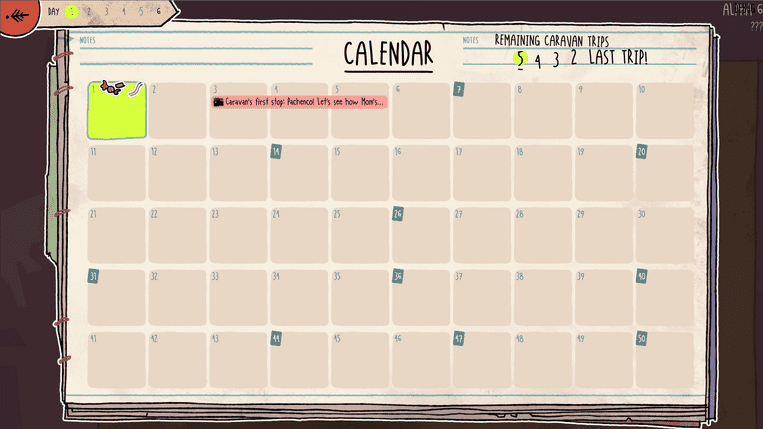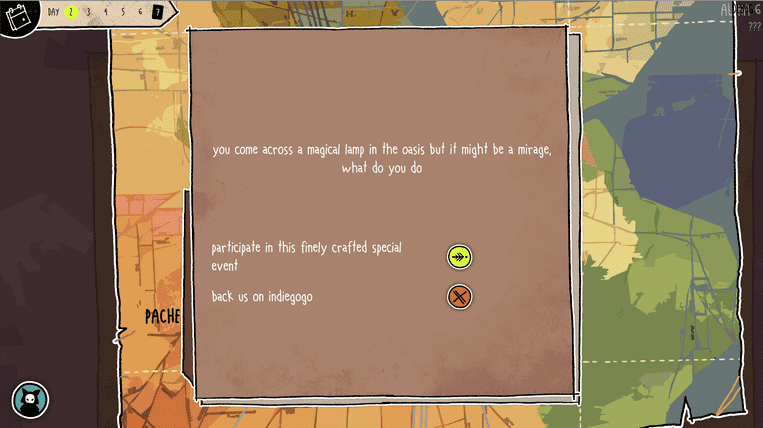Prototyping New Features in Signs of the Sojourner
by Dyala on October 14, 2019
As a small team, it's extremely important that we use our time efficiently. Part of that means verifying new ideas and features are doing what we need them to do, solving the problems they're meant to solve, in the fastest and usually most janky way possible. Only once we're able to verify that do we then spend the time making it look good and work correctly.
Of course, different features require different approaches and time spent in that prototype stage. I'm going to look at a couple recent features we've been working on.
The Calendar
A recent feature we've been working on is a calendar to help you keep track of all the various story threads in the game. The prototype stage for this was not so much about whether or not it worked or did what we want--we're not reinventing calendars here, they're a pretty well established concept. The unknown in this case was more about how we wanted things to work on the back end--when we want to draw the player's attention to it, how and when we trigger things getting scheduled into the calendar, and those sorts of implementation questions.
Generally new features always start with discussion with the whole team to identify goals and constraints. Often times this is alongside writing up an initial document for the feature and having everyone comment it up as well. In this case, Holly was able to start on mockups and working with Zach on the UI very shortly after those initial discussions, since there wasn't a huge number of unknowns. At the same time, Kevin was adding in some content to use the new feature, so we could test and make sure all the use-cases were covered.
Special Event Types
In contrast, Special Event Types have been in prototype-land for some time now. We know we want additional event types that break up the core loop, that present different narrative situations, and that use your deck or present deck-building choices that thematically fit in and expand the idea of your deck as your character.
We'd already gone through several prototypes for this, which we discarded as not adding enough value for the amount of time they'd take to actually make work well. Fortunately, with the Indiegogo campaign, we've been able to revisit the concept and explore new ideas whose scope fits better with our timeline.
This stage usually has several steps as well, with Zach doing the initial implementation with placeholder content, then me coming in to balance and fit it in to the current game flow, as well as updating to slightly less placeholder content. We're currently still in the prototype stage with this feature, but as things come together, the next steps once again require the whole team--Holly designing the UI and doing the final art, Kevin updating to final content and writing, me finalizing the balance and pacing, and Zach making it all actually work.
The Core Gameplay
This deserves a blog post of its own, but as you might imagine coming up with the structure around which to hang the rest of the game required a lot of prototyping, testing, and iteration. I couldn't tell you how many dozens of iterations we went through to land on the current core gameplay. That's a topic for a future post!
Prototyping New Features in Signs of the Sojourner
by Dyala on October 14, 2019
As a small team, it's extremely important that we use our time efficiently. Part of that means verifying new ideas and features are doing what we need them to do, solving the problems they're meant to solve, in the fastest and usually most janky way possible. Only once we're able to verify that do we then spend the time making it look good and work correctly.
Of course, different features require different approaches and time spent in that prototype stage. I'm going to look at a couple recent features we've been working on.
The Calendar
A recent feature we've been working on is a calendar to help you keep track of all the various story threads in the game. The prototype stage for this was not so much about whether or not it worked or did what we want--we're not reinventing calendars here, they're a pretty well established concept. The unknown in this case was more about how we wanted things to work on the back end--when we want to draw the player's attention to it, how and when we trigger things getting scheduled into the calendar, and those sorts of implementation questions.
Generally new features always start with discussion with the whole team to identify goals and constraints. Often times this is alongside writing up an initial document for the feature and having everyone comment it up as well. In this case, Holly was able to start on mockups and working with Zach on the UI very shortly after those initial discussions, since there wasn't a huge number of unknowns. At the same time, Kevin was adding in some content to use the new feature, so we could test and make sure all the use-cases were covered.
Special Event Types
In contrast, Special Event Types have been in prototype-land for some time now. We know we want additional event types that break up the core loop, that present different narrative situations, and that use your deck or present deck-building choices that thematically fit in and expand the idea of your deck as your character.
We'd already gone through several prototypes for this, which we discarded as not adding enough value for the amount of time they'd take to actually make work well. Fortunately, with the Indiegogo campaign, we've been able to revisit the concept and explore new ideas whose scope fits better with our timeline.
This stage usually has several steps as well, with Zach doing the initial implementation with placeholder content, then me coming in to balance and fit it in to the current game flow, as well as updating to slightly less placeholder content. We're currently still in the prototype stage with this feature, but as things come together, the next steps once again require the whole team--Holly designing the UI and doing the final art, Kevin updating to final content and writing, me finalizing the balance and pacing, and Zach making it all actually work.
The Core Gameplay
This deserves a blog post of its own, but as you might imagine coming up with the structure around which to hang the rest of the game required a lot of prototyping, testing, and iteration. I couldn't tell you how many dozens of iterations we went through to land on the current core gameplay. That's a topic for a future post!


